Content can serve a variety of purposes, but if it’s indexed on Google, it should be optimized to drive organic search traffic.
Businesses have many life cycles. Content marketing leaders come and go. Massive amounts of content are created, promoted, and forgotten. Why can’t you take all of those past campaigns and reinvest in them to give your organic traffic (and your customer experience) a significant boost?
Is it possible to rejuvenate old content and redistribute the link equity across a cluster of pages to increase your authority on a targeted topic?
In this webinar, Garrett Sussman and Kyle Marino show you how to do just that, giving you a powerful four-step framework you can use to extend the life of your content indefinitely.
Today, they’ll show you how to mold your old content to new circumstances, creating something that’s satisfying for readers, while also satisfying search engines.
The state of content in large organizations [5:33]
You have one job.
As an SEO lead or content strategist who is working on indexed content, your goal, your primary focus is on creating content that ranks well on Google. If searchers visit Google and they enter a query relevant to your business, you should appear.
If you’ve done it right, there’s a click.
Searchers see your content in the top three results, they click through to your site, and then (hopefully) there’s a conversion. This is the basic idea, right?
Here’s the problem.
The larger the company, the more content is produced. Often this content is created with no focus or emphasis on SEO, content strategy, or information architecture.
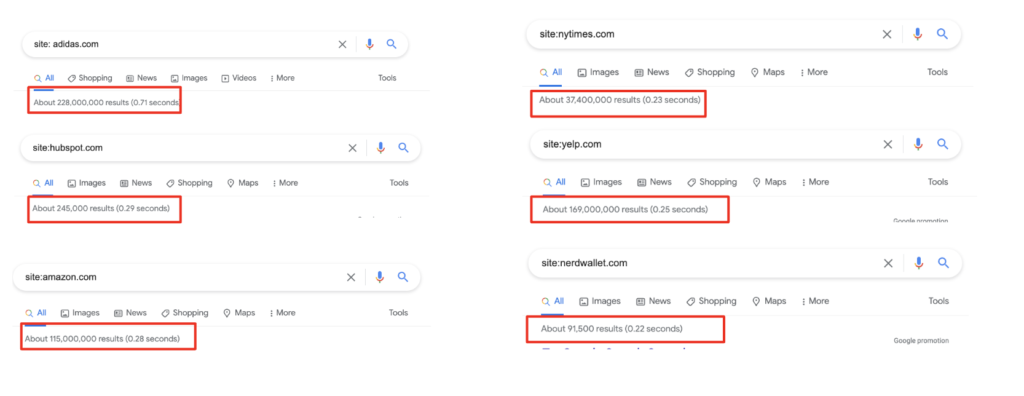
Oh, come on, what’s the big deal? Isn’t more content better?
No, not so much.
When focused purely on volume, performance is a mixed bag of results for organic search.
While some of your content may hit hyper traffic rankings (1-3) and striking distance rankings (11-20), there’s a good chance that a large portion of your content has failed to rank or generate traffic.

That’s a problem.
If your content is being indexed by Google, meaning it appears somewhere in Google’s search results, it’s important that it ranks well. When your content ranks well, your customers/audience can find the information they need when they need it.
Content that’s buried in the 125th result in Google, where no one will ever find it or click on it, is not helpful. Yet, that’s exactly the case at many large organizations. What do you do with the content that’s been indexed by Google but has failed to produce meaningful results?
Do you archive the pages as non-index and remove them from the sitemap?
Absolutely not. Use the equity of these pages as a foundation for future content pieces and initiatives.
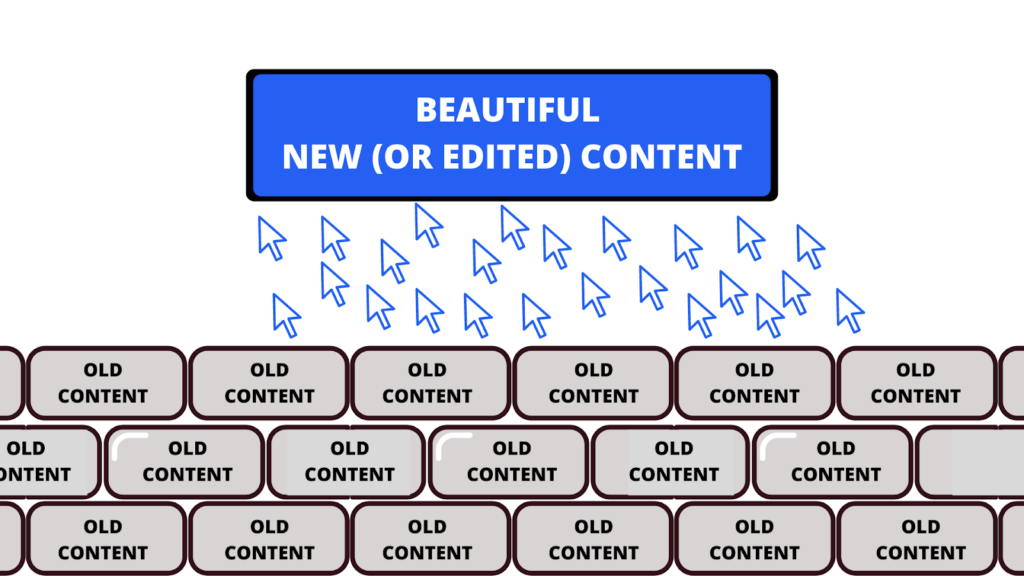
Instead, you create a content rebalancing strategy to leverage old content and claim (or reclaim) your brand’s authority.
What is content equity rebalancing? [11:56]
The term ‘equity rebalancing’ has been used in various industries for some time now. One of the most common is the financial industry.
Consider how you may adjust or redistribute your equity in a financial portfolio. The methodology is the same, just with a different focus.
In the financial sector, if one group or sector of your portfolio performs well (better than other sectors), you redistribute or rebalance your equity.
Same thing with content equity rebalancing.
Content Equity Rebalancing is the process of realigning the search equity of digital content assets, which in our case, are website URLs. This process allows you to realign or redistribute the value of underperforming pages through a process of updating, improving, or removing existing content.
The process is straightforward.
- Organize your content by topic
- Improve the quality of existing pages
- Fill in the gaps
- Connect relevant content with internal linking
This process redistributes the value of underperforming pages; you go through a decision workflow and determine whether a piece of content needs to be updated, merged, redirected, or trashed. This enables you to distribute your link equity or, if it’s performing well, leave it as is.
Why content equity rebalancing is important [16:47]
If you’re going to invest the time and energy needed to produce rankable content, you’ll need a firm understanding of why content equity rebalancing is important.
The answer is content decay.
Content decay refers to a consistent decline in organic traffic, rankings, and visibility. Every piece of content goes through a specific lifecycle.
- Momentum: Your content receives traction as Google indexes your content and determines whether it’s a good fit for searcher intent. Organic traffic builds slowly at this stage as your post is compared to other top performers.
- Growth: As searchers begin to share, promote, and engage with your content, traffic climbs. The more backlinks your piece receives, the greater your organic traffic. Each post’s growth period is different; it’s difficult to predict what will catch on. In this stage, the duration, volume, and speed of growth vary.
- Maturity: Traffic peaks and momentum begins to slow. It could be a traffic ceiling due to the monthly search limits for your topic or topic cluster; a competitor is making aggressive moves into the space, or the fact that your post isn’t receiving as many backlinks.
- Decline: Content ages like everything else. It becomes outdated, less relevant, or less competitive. When traffic, rankings, and visibility to your piece will begin to decline. In this stage, the duration, volume, and speed of the decline vary as well.
A rebalance also provides more internal linking opportunities to strengthen the relationship between related content.
Content Equity Rebalancing gives you the opportunity to:
- Leverage the data at your disposal to improve traffic and increase organic growth
- Rather than purely focusing on creating net-new content, you’re saving time and resources by utilizing existing content
- Optimize your website further with the type of content that is working while avoiding what’s not
How content equity rebalancing fits into your overall content strategy [20:31]
A rebalance gives you a tremendous head start. It’s as if you’re taking a ski lift up to the top of the mountain rather than trudging up the mountain yourself. With a rebalance, you have the ability to guard against or prevent more instances of keyword cannibalization.
This is crucial because it can be hard to keep track of and manage every piece produced. The good news is that a rebalance provides your audience with relevant content and an improved user experience. The last thing you want is to rank for an outdated piece of content that’s missing the mark on important details.
A rebalance is working smarter, not harder.
You’re utilizing the pieces of content that you’ve spent a significant amount of time or money creating.
In a 2021 survey, Orbit Media found that blog writers typically spend about an average of four hours per blog post; if you’re producing 20 blog posts per month, that’s 80 hours that you’d have to pay your in-house or outsourced writers to create.
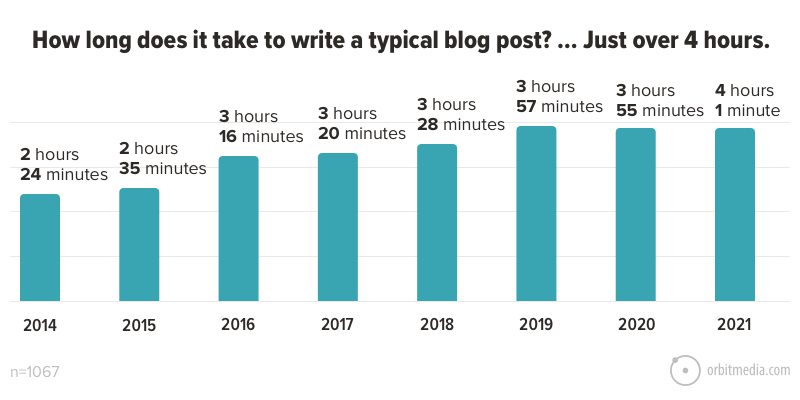
If you have a pool of content on these topics, you could spend two hours just merging two pieces together to create an even better long-form piece of content. When you prune content that’s targeting the very similar variations of keywords that have the same search intent with two different pages, you’re diluting your ranking potential for both.
Keyword Insights shared a case study that revealed exactly this scenario when they removed 15 million URLs and increased traffic by 110%.
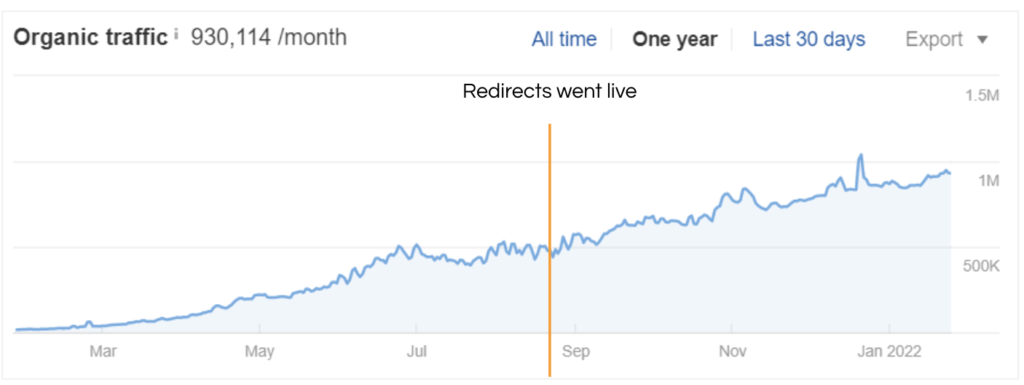
While a project like this can take a significant amount of time it’s important to carefully assess which topic cluster you attempt to rebalance because topic clusters aren’t created equal. Some have more value for your business than others.
What resources do you need? [30:29]
What common resources would you need to pull something like content equity rebalancing off?
Well, first things first, if your organization has an SEO analyst or search strategist, you’ll definitely want to loop them in on this. You’ll want to set things up if possible, so there’s active collaboration between both departments.
Where do you start?
- Identify the topic cluster your audience is looking for
- Outline your value propositions and what you’d like to rank for in the SERPs
- Analyze the overall search monthly search volume for the query itself, as well as identify long, long-tail keyword opportunities
It’s important to make the right decision with your keyword and topic clusters. Use tools Semrush and Ahrefs to get the ball rolling. These tools are fantastic because they provide ideas for the keywords and guidance when building out your keyword and topic clusters.

As you’re doing this research, think about the buyer’s journey. Make sure that you’re addressing keywords from the top of your funnel all the way to the bottom.
How to approach content equity rebalancing [33:23]
At this point, you have an idea of the topic cluster or clusters you’d like to pursue. Take a look at your own performance metrics. Head over to Google Search Console and Google Analytics; start pulling in all of the metrics that are relevant to your research.
Your content needs time.
Give your content pieces twelve months to perform. This will show you what you’re dealing with. Focus on the overall clicks, page visits, impressions, volume, average time on page, bounce rate, etc.
All of the metrics you’ll find in Google Search Console and Google Analytics.
Then create a repository.
If you’re working with an entire team or collaborating with your SEO team, drop your data into a spreadsheet, something like Google Sheets, where the whole team can collaborate. Use your repository for identification and tracking your progress, especially if you’re handing it off to different team members and everything.
Get the spreadsheet and the replay of the webinar below.
Take the time to consider what has direct business value to you, your company, and your products or services. As you audit your content, identify any sort of need state gaps in the buyer’s journey.
What does this mean?
You may have a lot of awareness pieces, but you don’t have a lot of content-level content pieces. Make sure you note that in your repository. You’ll want to list it as an opportunity to close the gap and strengthen your topic clusters overall.
If you’re going to invest this kind of time and effort into your content, make sure you invest time and effort into something that has a healthy amount of search volume. Don’t invest your time and effort into low-value or unattainable clusters.
Check out this example for the American Red Cross identifying a topic cluster around the head term CPR:
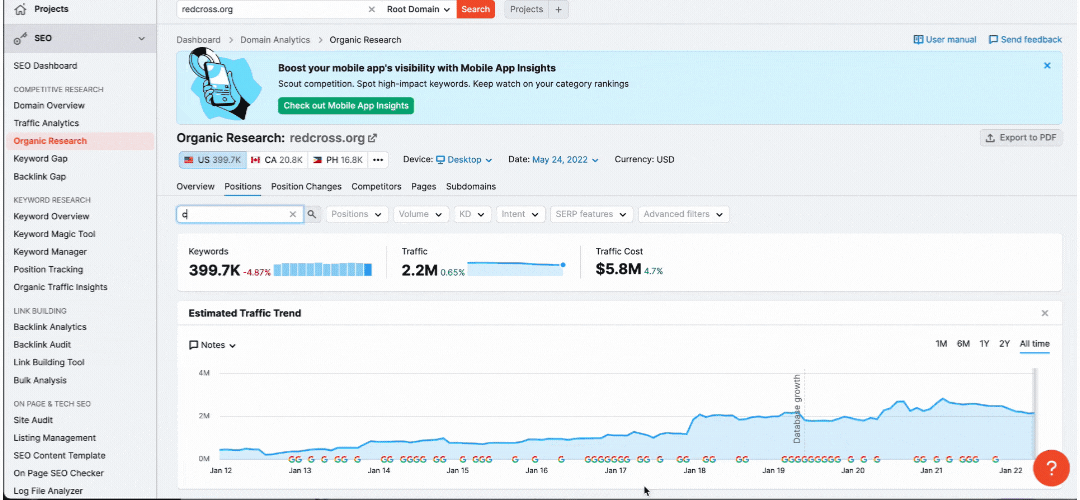
As you’re producing content, outline how it fits with the other need states in the buyer’s journey. Map out the other pieces that can expand on or answer the questions you’ve raised in your current piece. If you’re creating an awareness piece, identify the queries searchers would use if they’re in the consideration or decision phase.
This approach helps you to produce big-picture content.
Now that you have a list, the next step to rebalancing is to review their performance.
We recommend you review the metrics over a 12-month time period (at least).
- Clicks/page visits (GSC)
- Impression volume (GSC)
- Avg time on page (GA)
- Bounce rate (GA)
- # of internal links (3rd Party SEO Tool)
- # of backlinks generated (3rd Party SEO Tool)
- Conversion goals (if configured in Analytics)
- Social referral domains (GA)
- Pages per session (GA)
iPullRank has created an extensive scoring system based on specific metrics to identify the overall ‘score’ of each content piece. Content engineering.
Now it’s time to apply the refresh to your selected content.
Content rebalancing is decision tree workflow.
Based on the score of your URLs, we identify which pages would be ideal for one of the following categories:
- Refresh the content
- Merge content and redirect
- Redirect the URL entirely
- Keep the content as is
Higher scores: Keep the content as is.
Medium scores: Reassess for a merge opportunity or a refresh.
Low scores: Most likely a merge or redirect.
Keeping Content Pieces
As the category name suggests, this refers to simply leaving the content piece as is.
- There are different situations where this would be applicable.
- The first would be applicable for relevant content pieces that have high engagement metrics.
- The alternative would be that while they may appear for the relevant topic cluster, the post itself is not aligned with the new campaign.
Refreshing Existing Content Pieces
If you’re scoring results in strong engagement metrics, a minor refresh can help redistribute some of the content’s equity towards your intended campaign.
- Review the content to ensure it is still relevant. Update accordingly to offer recent insights.
- From there, make sure you add links to other relevant content pieces for your campaign. This can be other pieces being rebalanced or net new content created specifically for the campaign.
Merging Content Pieces
Old URLs that have valuable information but lack the necessary engagement metrics should be merged and redirected.
- These URLs typically contain top-level statements relevant to your campaign but lack the detail that would improve engagement.
- They can also be older pieces of content that may have valuable key points but are outdated.
- Rather than archiving or removing the content, salvage what you can and merge it into a new piece.
- Use the URL but redirect it to the new content asset.
- This process gives you the ability to create long-form content in less time.
Redirecting Content Pieces
URLs that possess digital equity but drive little to no engagement should be redirected to the top campaign page URL.
- While these URLs have little engagement value, they offer more equity than creating a piece of content on a new URL.
- More often than not, the content on these ‘redirect’ URLs is still valuable. Rather than just tossing it, catalog the content so you can refresh it and re-publish it at a later date.
- When you redirect, update your internal links.
301 Redirecting
A quick note about redirecting trashed or merged pages:
Redirecting is a technical process where your website content management system, redirection plugin or javascript tells a visitor to go to a different page on your site instead of the URL in their browser.
If you don’t have the ability to redirect, contact someone from SEO, web dev, or IT to execute.
How often should you rebalance? [48:16]
At iPullRank, we rebalance in a variety of circumstances.
For example, we conduct an audit each time we’re preparing to launch a content campaign for a client. The key here is tying it back to the business goals.
Believe it or not, ‘how often’ is often the wrong question.
Instead, you should be asking yourself, what is prompting this interest in producing new content?
- Preparing a net-new campaign
- Performance drop for a cornerstone topic cluster
- Identified content gaps for a topic cluster
- Resources to work on multiple clusters consistently
- Regular cadence (Annual, Quarterly, or seasonal)
- Event-driven
- SEO algorithm updates,
- macroeconomic events,
- world events or shift in search intent.
Ultimately, your organization’s goals will dictate how often you should audit.
It’s more about what’s driving the interest or desire to produce new content. Think about all the circumstances where content rebalancing makes sense for your organization — preparing to launch a new campaign, or you have an idea, and you need to see if that content already exists. Then there’s the incidental performance drop or negative trends.
The audit process helps you to identify the issue and figure out how to fix this.
In this case, rebalancing makes a lot of sense if you identify content gaps for a topic cluster. Let’s say that a topic cluster you uncovered six to eight years ago has really expanded and become more complicated, more nuanced, or more detailed. If you haven’t created content for those gaps, a rebalance can help you merge and fill those gaps quickly.
Work to consistently update your most important topic clusters at a minimum. Work that into your editorial schedule in your calendar, so it’s a regular part of content maintenance. You’ll also want to pay attention to event-driven cues (e.g., algorithm updates, pandemics, changes in keyword volume, etc.). Think about how your specific topic cluster is being searched and factor that into your rebalancing efforts.
About Garrett Sussman, Demand Generation Manager at iPullRank
Garrett Sussman is the Demand Generation Manager at iPullRank. He’s been in the content marketing and SEO game for the past 10+ years, working in various industries — SaaS, a design marketplace, digital marketing, and even Silicon Valley.
About Kyle Marino, Content Strategist at iPullRank
Kyle Marino is a Content Strategist at iPullRank. He has 13+ years in content development and strategy. He’s worked with smaller boutique creative agencies focused on local SEO, and he’s worked with SaaS resellers before finally landing at iPullRank








